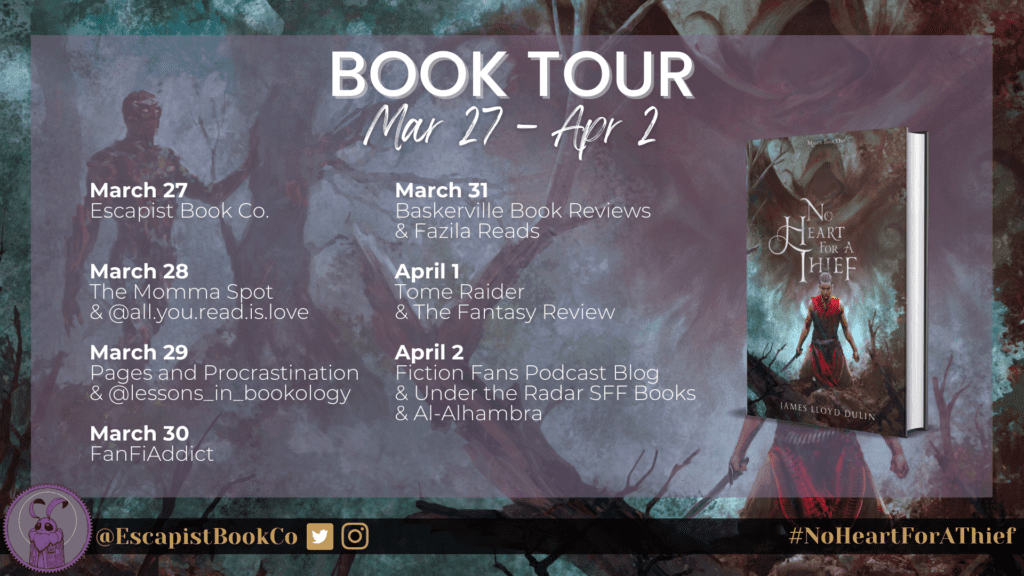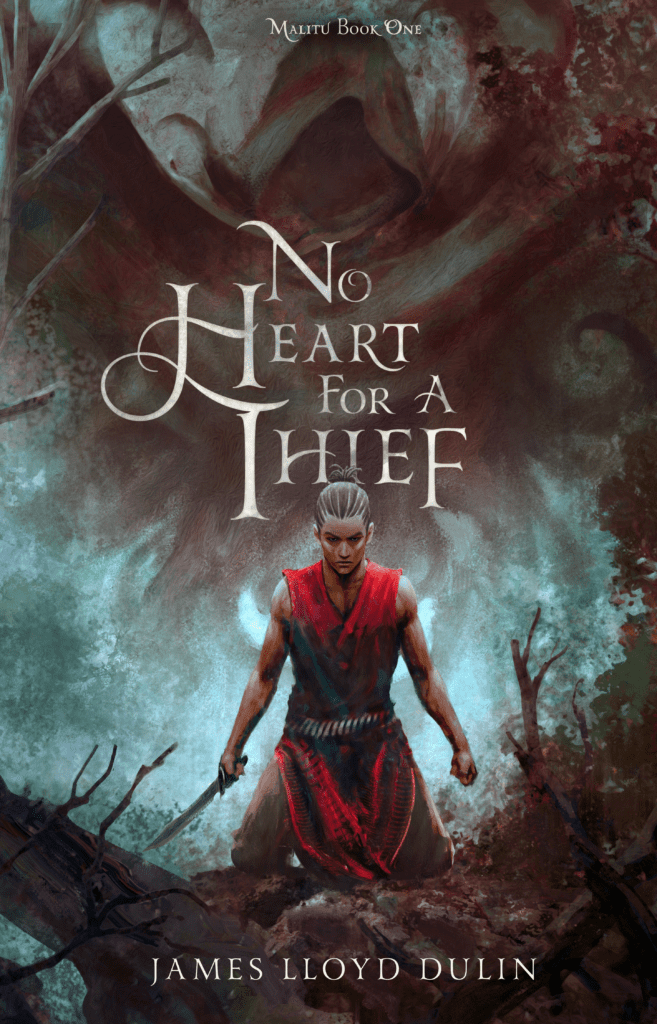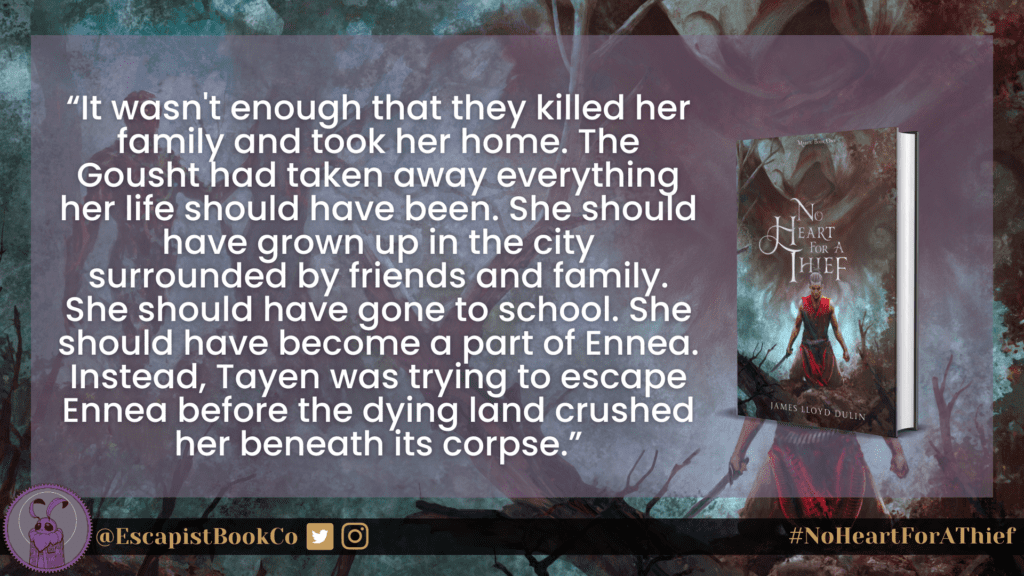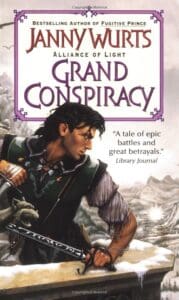
Hey, y’all! I am so thrilled to be part of this Escapist-hosted tour. As most of you probably know, I had the extreme privilege and pleasure to edit No Heart for a Thief. In the time since then, I’ve come to know James and honestly, I am proud to call him a friend. Still, nothing could have prepared me for what he had to say in this guest post. When I approached him with it, he was more than willing to participate, and boy did he deliver! I won’t say any more, though, and will let the author speak for himself. Enjoy!
Book Information

No Heart for a Thief by James Lloyd Dulin
Series: Malitu
Genre: Epic Fantasy
Intended Age Group: Adult
Pages: 428
Published: January 24, 2023
Publisher: G & D Publishing (Self Published)
Content/Trigger Warnings
- Graphic violence
- Violence toward children
- Derogatory behavior toward marginalized characters based on skin color and gender identity
- Colonialism
- Death of family members
- Drug addiction
- Survivor’s Guilt
- Religious manipulation
Alluded to (things only mentioned in passing or hinted at):
- Drug use
- Slavery
- Kidnapping
See Also
Cross The Hound with Mr. Miyagi • Build a Story like a Russian Nesting Doll with More Blood and Trauma • Add Moody Spirits
Book Links
Amazon US: https://www.amazon.com/dp/B0BLGPMNZG/
Silverstones Books (signed copies) – https://silverstonesbooks.com/product/no-heart-for-a-thief-signed/
Goodreads: https://www.goodreads.com/book/show/63219037-no-heart-for-a-thief
Read chapter one for free! – https://www.jamesldulin.com/previewchapter
Book Blurb
We are the stories we tell ourselves…even the lies.
The Thief, a great spirit, and her descendants have abused their ability to steal magic for centuries. When Kaylo starts to hear the song of other people’s magic, he must learn to hide from his people as well as the invaders. A gift or a curse, Kaylo may be able to save his people from the Gousht Empire that claimed their land with this stolen magic.
Eighteen years later, Kaylo still prays to the spirits, but not out of loyalty or love. He knows better than to rely on those selfish bastards for anything. While hiding in the forest from his foolish acts of rebellion, he encounters a girl, Tayen, being pursued by two soldiers of the empire. Against his better judgment, he risks facing the consequences of his past to intervene.
When Tayen attempts to run off seeking vengeance for her family, he offers to train her to wield her magic and a blade. If he can’t convince her to relinquish her need for vengeance and stave off the demons of his past, he’s going to get them both killed.
Difficult Conversations, but with Magic
Here’s what I wanted to say, and what I started to write.
Whether it is an expression of joy or an examination of pain, art has the ability to communicate beyond the bounds of discourse. Novels are greater than the sum of the words on the page, and paintings communicate more than the sum of the brushstrokes on the canvas. All of which makes art the perfect arena to discuss topics we struggle to engage with within our everyday world.
But I don’t know if it’s true. And let’s be honest, it’s overwritten.
I want to believe art can help humanize us to each other and critically analyze dangerous political beliefs, then I hear people’s responses to media. People can look at something like Star Wars and have disagreements as to whether the dark side represents the extreme right or the extreme left of the political spectrum. We have become so mired in team-centric political discourse that everyone paints the “good guys” with their own ideals.
On the other hand, there has to be some efficacy to the ability to communicate through art, or “anti-woke” politicians wouldn’t be seeking to ban books, complaining about racially diverse casts, or accusing media companies/creators of having agendas. They are obviously worried about artistic media’s ability to humanize people, examine dangerous ideologies, and interrogate oppression.
So, what is the answer? Does art create a path through difficult discussions or not?
I think it can, if people are willing to be vulnerable in their consumption of media. Changing one’s mind is a vulnerable endeavor. And I don’t think that avoiding conversations in our art does anything. We might as well try.
As a fantasy author, I’ll stick with what I know best.
Fantasy worlds can usher us away from the baggage of our real-world divisions if we let them. They can allow us to engage with thoughts in a space that is considered neutral when it is anything but. When authors are building their worlds, they have the ability to bring the conversations they want to have into their world and leave the rest behind. This allows authors to engage with isolated ideas, without having to tackle the weight of everything that is attached to them.
It isn’t often easy to engage with a single idea in the real world when that idea is entangled with thousands of others. And it can be even harder to remove our cultural lens from the ways we interpret the world. However, when a reader is experiencing a new world through the lens of a new culture, maybe the ideas that are explored can take on a different light.
When I wrote No Heart for a Thief, I wanted to engage with a conversation around colonialism and whiteness.* While these concepts aren’t the main focal point of the story, they affect the reality of the world for our point-of-view (POV) characters. Kaylo and Tayen have to navigate a world in which their history has been stolen from them, their people are in constant danger, and they cannot see a future without the effects of the empire that colonized their home.
I could go on about my intentions, and how I made the choices I did around having this conversation in my books, but the ways readers interpret my words is beyond my control—not to mention something I have no interest in controlling. Additionally, and more importantly, there are authors who are bringing their personal experiences to the page and able to engage in this topic in different ways than I will be able to.
N. K. Jemisin’s The City We Became directly engages with race, class, gender, sexual orientation, and more in a story that examines the boundaries between realities as worlds crash into each other. R.F. Kuang’s Babel is a conversation about race within education. Black Sun by Rebecca Roanhorse brings pre-colonized indigenous cultures of the Americas into a dynamic fantasy world.
The examples verge on countless. Authors engage with conversations through representation, analogy, and/or direct confrontation, often bringing the lived-experience of their identities with them.
For people who are weary of “heavy-handed” messages. Authors bring different conversations into their work in a myriad of ways. Sometimes authors engage simply by allowing different kinds of people to exist in their world. Other times the conversation is completely handled through metaphor. In fact, these conversations rarely express themselves the same way twice.
Hopefully, the themes authors present in their stories will lead to thoughts and/or conversations about how the themes in stories act within the real world. But that is the hardest part. Whether readers consume, interpret, and internalize the ideas within a story to the extent that they use those ideas to think about the real world is 100% on the reader.
All of this is to say, for readers who are open to engaging with ideas and cultures outside their perspective, fantasy can create space for conversations by removing some of the baggage in our real lives. Despite my cynicism, I believe art has that power.
I understand some people read to escape. In that escape, we are interacting with people in fantastical situations. Their humanity roots us in the worlds authors create. Why not escape into a space in which we are also vulnerable enough to take in a new perspective?
* Whiteness is not synonymous with white people. When I refer to whiteness, I am referring to a culture that seeks to assimilate and appropriate in order to garner power at the expense of Black, Indigenous, and other people of color. Whiteness is a claim of who is valued and deserves power in a system of white supremacy, and it is one that changes and adapts to remain in power. We see this in how the category of white has grown to include different groups/ethnicities in a relatively short time period in order to maintain power.
About the Author

James is a nerd with a head full of stories and limited time to put them on the page.
He grew up in Grand Rapids, MI, spending an excessive amount of time at a local community theater where he developed his affinity for storytelling. This affinity grew into a deep admiration for language and spoken word poetry while studying mathematics and education at the University of Michigan. A few hundred mediocre poems and lackluster performances later, he decided his dream of writing a novel might not be as ridiculous as he once thought. He firmly believes that art—even silly books about magic, or maybe especially silly books about magic—has the ability to tell stories that sink beneath the surface.
Author website: https://www.jamesdulin.com/
Twitter – https://twitter.com/JamesLDulin
Instagram – https://www.instagram.com/jameslloyd27/





Leave a Reply